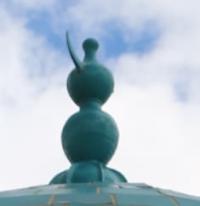You are here
Dome of Zhoshi Khan Mausoleum.

Sacred places of Ulytau.
“The sculptured top of the mausoleum, resembling a head with horns, attracts attention. It is made of fired pottery clay. At the base of the sculpture, on the platform of the drum, there is a round pedestal in the form of a figured plate with a diameter of 34 cm. On the pedestal rise two large vases, 30 cm high, inserted one into the other. They are fixed to each other with a wooden rod, cemented inside; the connecting tube in the form of a neck was inserted into the lower vase. Two bull horns are attached to the shoulder part of the upper vase. The cult of the bull, dating back to ancient traditions, existed in the first quarter of the 13th century. The bull was one of the most powerful totems among the Turkic-Mongols. The image of a bull has symbolized strength, power and might for centuries. The gray bull was often placed in a row with the blue sky. The Kazakhs have astrological myths according to which the earth rests on the back of a gray bull.»
Archaeological monuments of Kazakhstan. Alma-Ata, "Science" KazSSR, 1978. 214 p. "Remains of settled settlements in Central Kazakhstan".
Stone-sculptural art of Turkic Khaganate era.
The term Kubba, in Islamic architecture, is the concept of the top of the dome as a designation, as well as the dome itself and even the mausoleum, is cited in some sources. And translated from Arabic - the dome detail of the building. Kubba was discovered in the tomb of Zhoshi Khan in 1973 during the Central Kazakhstan expedition organized by the Ministry of Culture of the Kazakh SSR (M.K. Sembin, M. Mamanbayev, M.S. Nurkabayev).
The discovery and identification of the finds were carried out by Sembin M.K. Inv 1983 archive of the RSE "Kazsite". Manuscript No. 379 contains information about the monument to Jochi Khan and has been confirmed to date by Doctor of Historical Sciences Senbin Marat Kataevich.
It was installed on the roof of the former small dome in the XVth century, and later, when the dome was destroyed, it was also broken, and the remains were found in the form of fragments covered with high-quality blue glaze in the same place.
The upper part of the dome of the Jochi Khan mausoleum (Kubba) is complex of several elements. They are ceramic "bottomless vessels" filled inside with "alabaster" mortar, so that the outer layer is covered with blue glaze (glass clay), and inside - with a wooden core inserted into a groove on the roof of the dome through one izdі line, so that the rod remains strong.
The lowest part of the upper element was in the form of an inverted bowl (but without this detail), covering the groove of the dome through which the rod passes. On it is put a vessel resembling a bottomless jar, with a narrow and thin neck at the bottom and a round body at the bottom.
The upper part put on it has preserved the remains of strongly curved traces of "horns" on both sides. They are decorated with an image of two horns forming a crescent. Two horns were found, they are curved in the form of flat ribbed and sharp fragments. In this collection of finds, some elements are missing.
According to the tabular data of one of the researchers of the mazar of zhoshykhan, the famous architect-restorer Elena Khristoforovna Khorosh, after the reorganization of the scientific and restoration association "Kazrestavratsiya" the found finds were left in the building of the Institute "Kazproektrestavratsiya" (later transformed into the Research Institute of Monuments of Material Culture of the Ministry of Culture of the Republic of Kazakhstan).
Unfortunately, among them there were no other fragments above, found in the monument, reflected in the report and taken into account by researchers in graphic reconstructions ("bowls with ribs", etc.). fragments and another small "bottomless vessel", poured inside the plaster and inserted into it with a wooden core).
In 1998, the scientific and restoration association "Kazrestavratsiya" during the restoration of the mausoleum of Jochi Khan used the kubba installed on the roof of the dome for reconstruction. From 2009 to 2011, the items listed in the table were in the Kazakh Research Institute for the Cultural Heritage of Nomads.
Due to the closure of this institute, in 2011 they were transferred for storage to the National Historical, Cultural and Natural Reserve-Museum "Ulytau". Currently, the found parts and horns are being reconstructed and put on display in the museum's exhibition hall.
Geographical coordinates of Zhoshi Khan Mausoleum: N48°09'19 E67°49'02
Authority:
Chief Curator of the National Historical, Cultural and Natural Reserve-Museum B. Shaigozova.
https://ulytaureserve.kz/748-osobennost-kupola-dzhoshihana-kubba.html
Photos by:
Alexander Petrov.







